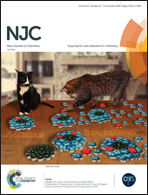Poly(β-cyclodextrin) enhanced fluorescence coupled with specific reaction for amplified detection of GSH and trypsin activity†
Abstract
Up to now, the successful fabrication of efficient specific reaction-based sensing systems for amplification signal-enhanced detection of reactive species remains an unsolved problem. To address this issue, we describe herein a universal β-cyclodextrin polymer (β-CDP)-based sensing platform that uses an amplified fluorescence assay for sensitive detection of glutathione (GSH) and trypsin activity. More specifically, the negatively charged peptide Py-GC adsorbed on the surfaces of MnO2 nanotubes via electrostatic interaction. Upon addition of GSH, MnO2 was reduced to Mn2+ and Py-GC was separated far from the nanoquencher, generating an activated fluorescence signal. It was worth noting that free pyrene could easily enter the hydrophobic cavity of β-CDP, accompanied by significant fluorescence enhancement. The nanoprobe exhibits high sensitivity and selectivity to GSH as well as excellent biocompatibility, making it a promising probe for imaging of endogenous GSH in living cells. As a proof-of-principle, we use this approach to quantify trypsin activity on the basis of the trypsin-catalyzed hydrolysis reaction of cytochrome c (Cyt c) in human serum. As a universal βCDP-based signal amplification reporter, this prototype can be applied to a sensitive and versatile sensing platform for multi-analyses by selecting suitable switched-reagents, thus inspiring the new strategies for bioanalysis.



 Please wait while we load your content...
Please wait while we load your content...